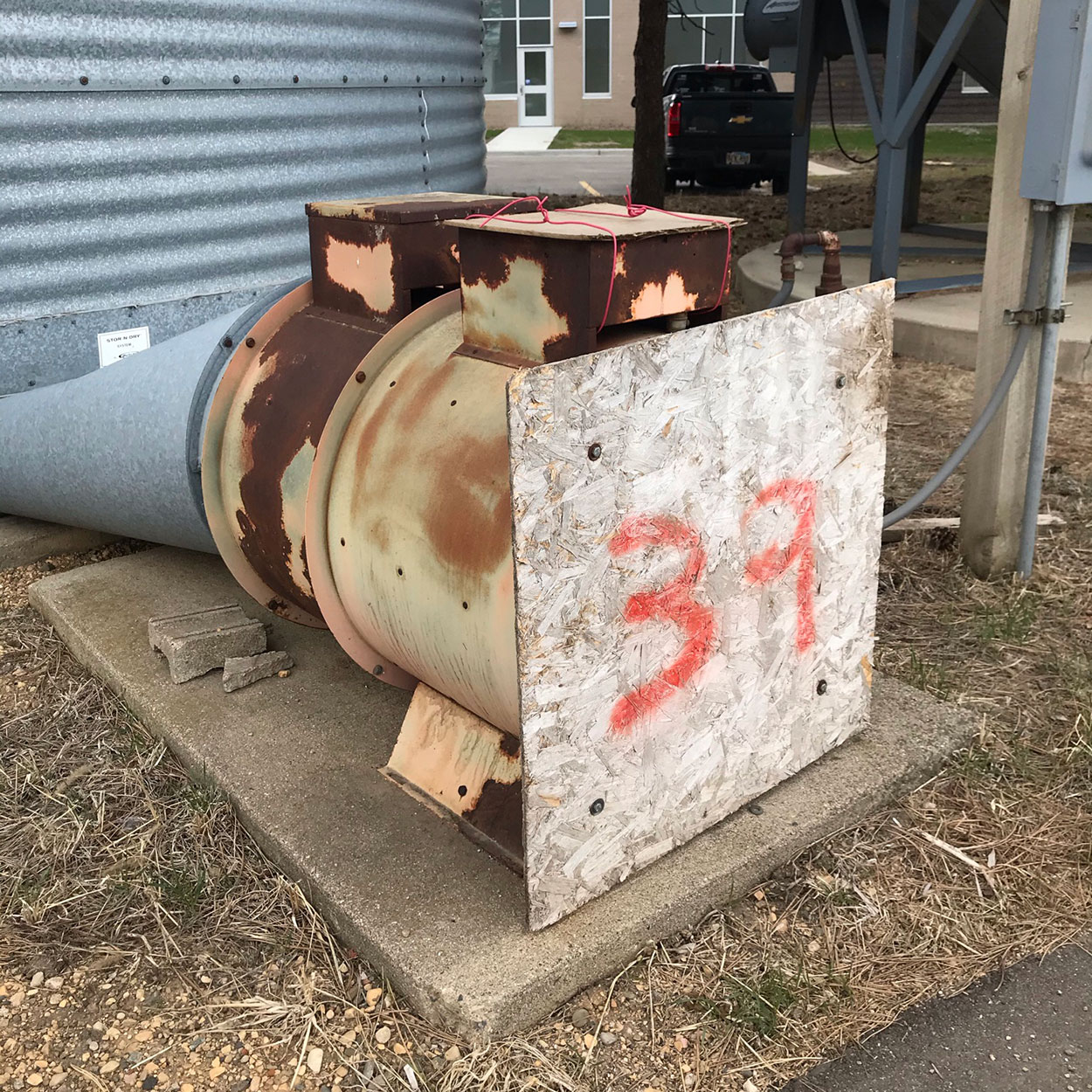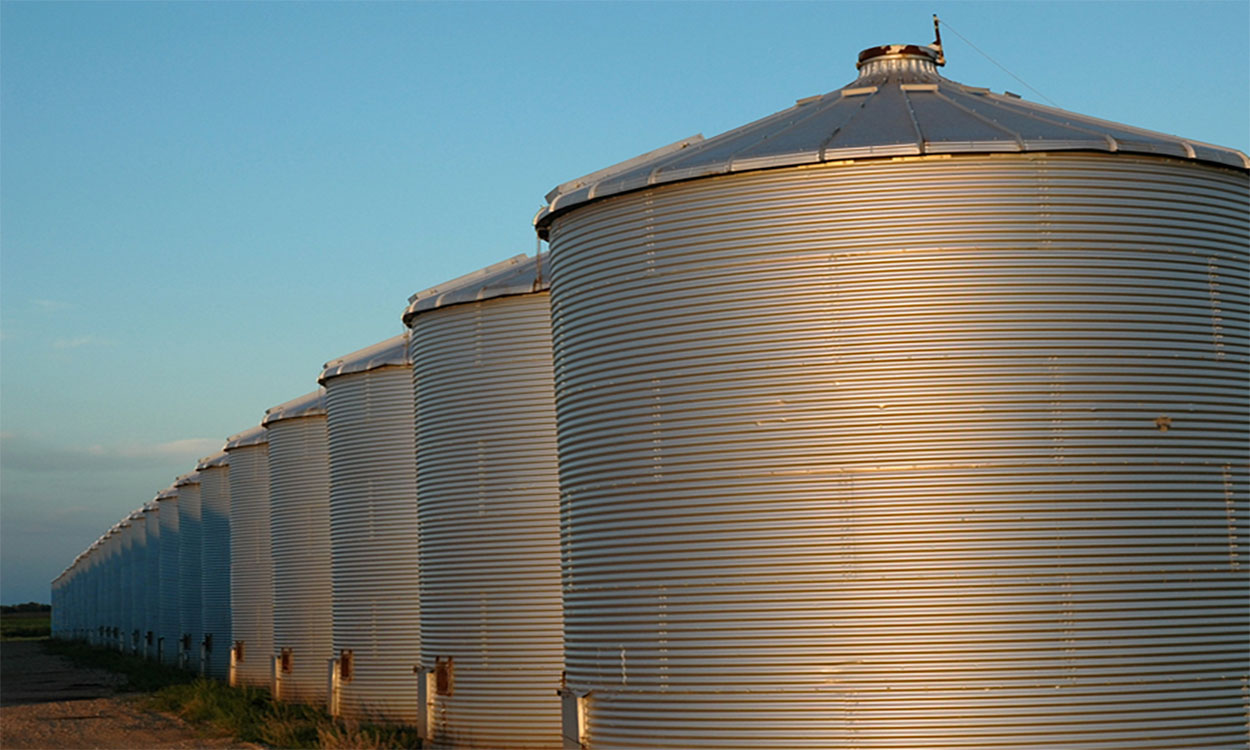Originally Submitted: April 29, 2021
As it warms up this spring, don’t forget to check the bins. Grain bins work as solar heat collectors, and the grain inside of them may be much warmer than expected. As the weather changes in the spring, keeping stored grain as cool as possible should be a producer’s goal.
Storage Temperature and Moisture Levels
It is ideal to keep higher-moisture grains near or below 30 degrees Fahrenheit during the spring season until grain reaches recommended storage moisture levels (Table 1). After grain is adequately dried, it should be kept at or below 40 degrees Fahrenheit through the rest of spring and early summer, or as long as feasible. Throughout mid-to-late summer, it is best to keep the storage temperature for dried grain below 60 degrees Fahrenheit if possible, which limits insect activity and potential mold issues. See Table 2 for the approximate allowable storage time of cereal grains; remember that allowable storage time is cumulative, so fall temperature and moisture have a large impact on spring storability.
“Allowable storage time” is considered the time before quality grain loss is expected. Airflow may help maintain grain temperature but will not extend allowable storage time. Allowable storage time listed in Table 2 is cumulative, for example: if 20% moisture corn were stored for 25 days at 50 degrees Fahrenheit, one-half of the storage life has been used. If the corn is cooled to 40 degrees Fahrenheit, the allowable storage time at 40 degrees Fahrenheit is only 45 days.
| Crop |
|
|---|---|
| Corn |
|
| Soybean |
|
| Wheat |
|
| Oil Sunflowers |
|
|
|
||||||
|
|
|
|
|
|
|
|
|
|
|
|||||
|
|
|
|
|
|
|
|
|
|
|
|
|
|
|
|
|
|
|
|
|
|
|
|
|
|
|
|
|
|
|
|
|
|
|
|
|
|
|
|
|
|
|
|
|
|
|
|
|
|
|
|
|
|
|
|
|
|
|
|
|
|
|
|
|
|
|
|
|
|
|
|
|
|
|
|
|
|
|
|
|
|
|
|
|
|
|
|
|
|
|
|
|
|
|
|
Adapted from “Approximate” Allowable Storage Timefor Cereal Grains.
Spring and Summer Storage Tips

- Cover bin aeration fans when not in use (Figure 1). Fans essentially go through the ‘chimney effect,’ where wind moves wet, warm air into the fan, and it travels upwards, affecting the grain inside.
- Provide an inlet for air near the roof eave and outlet exhaust near the roof peak to allow warm air to exit the bin (much like the principles of an attic). Several vents at the same elevation can still allow heat to remain at the top of the bin without exhaust at the peak or roof exhaust fans.
- Add a temperature sensor near the south wall of the bin to collect readings, or be sure to take some grain samples from this area, which is likely the warmest part of the bin.
- Periodically run bin fans throughout the spring to help keep grain cool and slow warm-up.
- During summer months, choose cool mornings every two-to-three weeks to run the aeration fan to keep grain cool and push cool air up through warm grain near the top of the bin.
- Run the fan only long enough to cool the grain at the top of the bin; this may mean running fans for a couple hours on more than one cool, dry morning. However, running fans more than necessary could result in grain warming near the bottom of the bin.
- Unload some grain. By unloading grain in bins with center sumps, warm grain from the top of the bin is unloaded first, leaving a funnel shape in the center of the stored grain. This can help to reduce grain temperature near the top of the bin and eliminate cone-shaped peaks (which lead to excess grain warming).
- Check your bin airflow rates. Visit the University of Minnesota Extension’s Online Fan Selection Tool for more information on fan selection.
Measuring Grain Temperature and Moisture
Throughout grain storage, but especially during the spring and summer months, producers should check stored grain every week (or as often as possible) for storage temperature, insect infestations and mold growth. Grain temperature should be measured at several places along the walls of the bin, near the top surface and within the grain. Temperature sensors are very useful for this, however multiple readings are necessary to get an accurate picture of overall temperature. When using a moisture meter to check grain, be sure to warm up samples to room temperature in a sealed container for several hours before measuring.
Stored Grain Insect Pests
Warmer temperatures both outdoors and in bins also mean increased activity of stored grain pests. During the spring it is important to monitor grain for insect activity. Some of the indicators of an infestation include hot spots in the bin, strong odors, excess dust, grain with visible damage and discolored grain. Keeping the grain cool will also slow insect activity. However, routine examination of the bin will provide the best opportunity to catch stored grain pests early and prevent extensive damage from occurring. For additional information and identification of stored grain pests please refer to our earlier article, Steps to Prevent Stored Grain Infestations. If you do detect an infestation and are considering using a fumigant insecticide product, we strongly recommend hiring a professional, as these products are highly toxic.
References and Resources
- Hellevang, K. Keep Stored Grain Cool During Spring and Summer. North Dakota State University Extension Service. 2018.
- Hellevang, K. Proper Spring Grain Drying and Storage Critical. North Dakota State University Extension Service. 2019.
- Scott, J. 8 Tips for Long-Term Grain Storage. Successful Farming. 2018.


